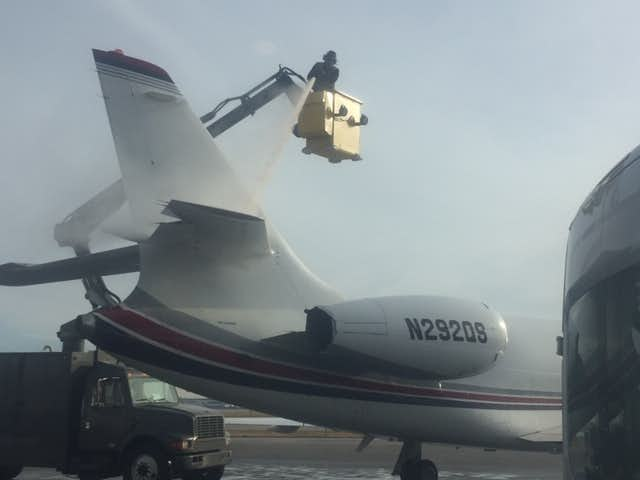
If you’ve mainly flown commercially, on a corporate jet or with friends, you may not have thought about deicing in terms of who’s paying for it. So you bought a jet card. Congratulations – you just made your life easier for you and whoever will be flying with you! As you sit in the FBO on a cold winter’s day and watch the truck pull up next to your jet, you might think, “Geez, I’m glad I’m not that guy on the boom lift. It must be cold up there!” You may not have realized that what was coming out of the hose was not just fluid, but money, possibly yours. Chances are you won’t find out about it until you get your monthly statement weeks late. I say possibly because some jet card programs include deicing and others don’t.
The cost of deicing can range for around $1,000 to $10,000 depending on the size of aircraft and airport. The reason it varies by the airport is each state, city, and airport authority may have different rules governing what types of fluids can be used, where aircraft can be deiced and procedures from preventing runoff seeping into the ground. In other words, it’s an expensive process.
Quick math says if you bought a 25 hour jet card and used it for 10 two-and-a-half-hour flights, of which five required deicing – depending on where you live and where you go not out of the question – at $5,000 per incidence that could add an extra $25,000, or essentially $1,000 per hour.
With on-demand charter, you always pay for deicing, another reason it makes pricing comparisons difficult. I’ve even heard about getting hit with two deicing bills for a single flight. The aircraft had to be deiced before a short ferry flight to pick up the passengers, and then because of the wintery conditions, had to be deiced again before the actual charter segment.
A good broker who is on the ball will work with the operator to minimize deicing. For example, it might be less expensive to pull an airplane into a heated hangar so that it is clear and based on conditions, may not need to be deiced. I think that the same philosophy comes when buying jet cards. If your jet card provider includes deicing as part of your hourly rate, they have more of an incentive to minimize the costs by being creative when possible.
So which jet card providers include deicing as part of their standard program? Interestingly, several companies that do really don’t advertise it, so just looking at their website may not tell you. It’s one of the 65 variables between programs we compare at Private Jet Card Comparisons.
“One if our core brand tents is thoughtfulness and we also have a cultural belief of simplification…We prefer to have our pricing and our charges very transparent and straightforward,” says Andrew Collins, CEO of Sentient Jet, which does include deicing. He adds, “This is due to the fact that, as an industry, we can be quite convoluted in how we charge. We believe in not making the client have to over-think things.”
The counter to including deicing from providers that don’t include it, they say, if you are doing flights where you won’t need deicing, a program that includes it is baking deicing for other members into your rate. That may be true, however, you can still compare inclusive program rates to ones that don’t have it. From what I’ve seen there isn’t a direct correlation, you really do have to look at your specific travel patterns, including peak day travel and surcharges, roundtrip discounts, long-flight discounts, fuel surcharges and so forth.
If you expect to do winter flying, you should anticipate the extra cost for deicing, or look at programs that include it. To help you out, here’s a list of jet card providers that include deicing in the program cost. In other words, there’s not an extra charge as long as you are within your Primary Service Area.